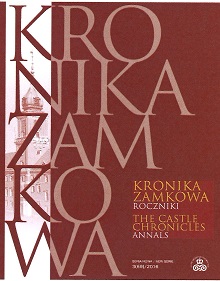Niezwyczajna kolekcja : "Gabinet sztuki Władysława Zygmunta Wazy" w świetle badań technicznych i technologicznych.
An unsual collection. Władysław Zygmunt Vasa's Kunstkammer in the light of technical and technological tests
Author(s): Regina DmowskaSubject(s): Fine Arts / Performing Arts, History of Art
Published by: Arx Regia® Wydawnictwo Zamku Królewskiego w Warszawie – Muzeum
Keywords: Art cabinets; Kunstkammer; techniques and technology of seventeenth-century art; Władysław Zygmunt Vasa; Jan Brueghel the Younger; Heere; Grand Tour
Summary/Abstract: The painting Prince Władysław Zygmunt Vasa’s Kunstkammer, now in the collection of the Royal Castle in Warsaw – Museum, signed: Here, fecit/Warsau 1626, was executed in 1626 as a painted record of the works of art, which the future King Władysław IV of Poland purchased for his art collection during the course of his European Grand Tour in the years 1624–1625. The painting’s later fate, between 1667 and c. 1940, is unknown. It then appeared on the American art market as attributed to Jan Brueghel the Younger and later in 1988 it was purchased by the Royal Castle in Warsaw. Prince Władysław’s Kunstkammer, an unusual example of this genre, contains more than forty works of art dating from the seventeenth century, including mainly paintings attributed to painters of the Flemish school (A. van Dyck, P. P. Rubens, Jan Breughel the Elder, and others), as well as sketches, drawings and prints (B. Strobel, H. Goudt), a bronze after Giambologna, and a gilded medallion from the workshop of A. Abondio. The painting, which bears the artist’s surname—no other works by him are known—underwent a technical and technological examination due to its unresolved attribution and some ambiguity regarding the composition. It was made using oil on panel, and underwent conservation work several times, and because of cracks in the support it was reinforced with parquet; the face of the painting was partially cleaned and retouched more than fifty years ago. Many non-invasive examinations were performed: VIS, UV, IR, RTG, XRF, as well as a stratigraphy, analysis of the pigments, fillers and binders on cross-sections of samples taken from the painting, and also a dendrochronological examination of the oak support. It was established that 1621 was the earliest possible year that the painting could have been executed. The tests revealed that it had a layered construction, and determined the technical makeup of the work, and the artist’s palette. The materials used are typical of paintings by northern-European artists of this period. An analysis of the painting’s construction revealed the existence of two oval pictures from the first stage of painting (the outline of one is largely decipherable), which were completely overpainted in subsequent compositions. In the next phase of the work, some of these were also partially overpainted with three new images (including a portrait of the prince). Moreover, the examination of the work proves that it was executed by two followers of the artists of varying talent: the first of these artists started and masterfully depicted the main part of the collection, while the second, lesserskilled one (whose surname was Heere?), was responsible for the three central pictures, documenting the prince’s jewelry, souvenirs and probably also for the final modelling of the theatre decoration. An examination of the painting clarified the manner in which many fragments of this complex composition were created, which are a result of the pentimenti. However, a complete analysis of the painting remains a matter for the further research and conservation treatment, which may in turn lead to determining its enigmatic authorship.
Journal: Kronika Zamkowa. Roczniki
- Issue Year: 3/2016
- Issue No: 3
- Page Range: 59-80
- Page Count: 22
- Language: Polish

